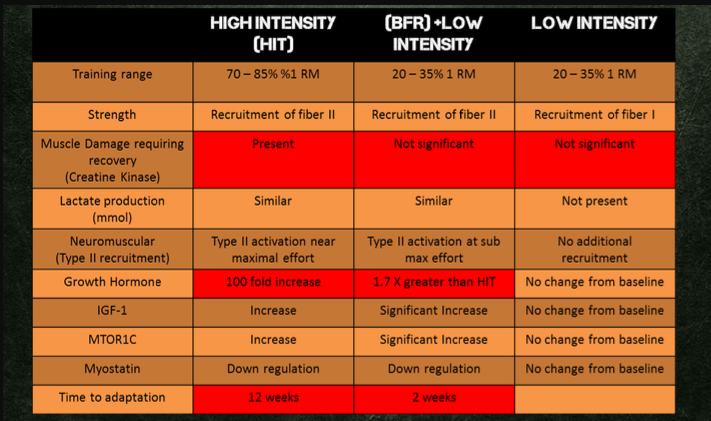Blood flow Restriction (BFR) training may seem like the newest trend to hit both the rehab and sport performance worlds, but in reality, BFR training has been studied and utilized since the first published study in 1998.
Maybe you have witnessed some bodybuilders in the gym performing exercises with bands tied around their arms or legs, or perhaps you have caught a story on ESPN reporting the benefits of BFR training for professional athletes. “From bodybuilding to rehabilitation, BFR is the future of intelligently designed muscular strength and hypertrophy programming, and for good reason, it produces results.” – ESPN
Blood Flow Restriction training is a revolutionary shift in rehabilitation
A tourniquet, similar to a blood pressure cuff, is applied to the injured limb to restrict approximately 80% of blood flow while the patient engages in strength training. Unlike traditional strength training methods that require loads >65% 1RM to make appreciable gains, this form of training is performed at very low resistance (20-35% 1RM).
For example, with BFR training, a 20# weight becomes equivalent to >65#. From a strength training perspective, BFR is a great tool, but from a Physical Therapy perspective, BFR gives us an amazing advantage.
So what is happening here?
How does BFR create a similar hypertrophy and strength stimulus but with way less work?
One word: Science
Muscle Protein Synthesis – Muscle Protein Breakdown
= Amt. of Muscle Growth
The Science
The goal of BFR training is to restrict approximately 80% of blood flow to the proximal extremity of your choice.
With approximately 80% of blood flow being restricted, there is limited oxygen to the muscles, which means the slow twitch (type I) muscle fibers, that rely on oxygen for fuel, are OUT, and fast-twitch (type II) muscle fibers, are IN. Unlike slow twitch fibers, fast twitch fibers have the largest potential for hypertrophy and strength gains.
Next, there is a large accumulation of lactic acid in the limb, which causes the limb to swell and increases the amount of metabolic stress to the muscle. This is what causes that deep “burning” feeling in the muscle that is similar to lifting heavy weights during a hard workout. This “burn” is simply the body’s response to being in an acidic and anaerobic environment. This amount of metabolic stress tricks the brain into thinking you are doing way more work than you really are which causes the brain to turn on the protein synthesis switch, and signals the release of the growth hormone. Growth hormone plays an important role in collagen synthesis by protecting our tendons and joints, which is extremely beneficial in post-injury rehabilitation.
Growth hormone secretion levels are 170% higher after BFR training than traditional resistance exercises.
Lets go back to that equation:
Muscle Protein Synthesis – Muscle Protein Breakdown
= Amt. of Muscle Growth
The tourniquet creates a hypoxic environment optimal for protein synthesis without muscle damage. This means, no muscle soreness, no muscle breakdown, and no more disuse atrophy and muscle wasting after injuries.
Summary of everything discussed above:

Blood Flow Restriction from LiftersClinic.com
Is it safe?
Now you may be thinking this BFR thing sounds great, but is applying a tourniquet really safe? The answer for most people is yes, however, there are some populations this is contraindicated for, therefore we don’t recommend that people tie bands around themselves and do this at home. In the clinic, we use a specific device that accurately monitors the amount of pressure to the limb and we follow very specific protocols. Current contraindications include but not limited to: a history of deep-vein thrombosis, pregnancy, varicose veins, high blood pressure, and cardiac disease.
BFR is changing the way we do rehab, but it is NOT for everyone
BFR isn’t a replacement for heavy training, it is a supplement. BFR is very useful for people who can’t train heavy due to injury but can also be beneficial as part of a de-loading program for healthy individuals and athletes.



